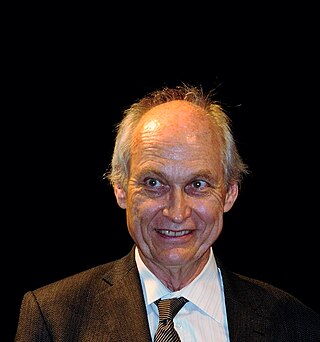Related Research Articles

Murray Gell-Mann was an American physicist who played a preeminent role in the development of the theory of elementary particles. Gell-Mann introduced the concept of quarks as the fundamental building blocks of the strongly interacting particles, and the renormalization group as a foundational element of quantum field theory and statistical mechanics. He played key roles in developing the concept of chirality in the theory of the weak interactions and spontaneous chiral symmetry breaking in the strong interactions, which controls the physics of the light mesons. In the 1970s he was a co-inventor of Quantum Chromodynamics (QCD) which explains the confinement of quarks in mesons and baryons and forms a large part of the Standard Model of elementary particles and forces.
Arthur Strong Wightman was an American mathematical physicist. He was one of the founders of the axiomatic approach to quantum field theory, and originated the set of Wightman axioms. With his rigorous treatment of quantum field theories, he promoted research on various aspects of modern mathematical physics.

Kenneth Geddes "Ken" Wilson was an American theoretical physicist and a pioneer in leveraging computers for studying particle physics. He was awarded the 1982 Nobel Prize in Physics for his work on phase transitions—illuminating the subtle essence of phenomena like melting ice and emerging magnetism. It was embodied in his fundamental work on the renormalization group.

Michael S. Turner is an American theoretical cosmologist who coined the term dark energy in 1998. He is the Rauner Distinguished Service Professor Emeritus of Physics at the University of Chicago, having previously served as the Bruce V. & Diana M. Rauner Distinguished Service Professor, and as the assistant director for Mathematical and Physical Sciences for the US National Science Foundation.
The Dannie Heineman Prize for Astrophysics is jointly awarded each year by the American Astronomical Society and American Institute of Physics for outstanding work in astrophysics. It is funded by the Heineman Foundation in honour of Dannie Heineman.

Barry Martin Simon is an American mathematical physicist and was the IBM professor of Mathematics and Theoretical Physics at Caltech, known for his prolific contributions in spectral theory, functional analysis, and nonrelativistic quantum mechanics, including the connections to atomic and molecular physics. He has authored more than 400 publications on mathematics and physics.

Ludvig Dmitrievich Faddeev was a Soviet and Russian mathematical physicist. He is known for the discovery of the Faddeev equations in the theory of the quantum mechanical three-body problem and for the development of path integral methods in the quantization of non-abelian gauge field theories, including the introduction of Faddeev–Popov ghosts. He led the Leningrad School, in which he along with many of his students developed the quantum inverse scattering method for studying quantum integrable systems in one space and one time dimension. This work led to the invention of quantum groups by Drinfeld and Jimbo.
Robert B. Griffiths is an American physicist at Carnegie Mellon University. He is the originator of the consistent histories approach to quantum mechanics, which has since been developed by himself, Roland Omnès, Murray Gell-Mann, and James Hartle.
Peter van Nieuwenhuizen is a Dutch physicist. He is now a distinguished Professor at Stony Brook University in the United States. Van Nieuwenhuizen is best known for his discovery of supergravity with Sergio Ferrara and Daniel Z. Freedman.

Marvin Leonard "Murph" Goldberger was an American theoretical physicist and former president of the California Institute of Technology.
Daniel Zissel Freedman is an American theoretical physicist. He is an Emeritus Professor of Physics and Applied Mathematics at the Massachusetts Institute of Technology (MIT), and is currently a visiting professor at Stanford University. He is mainly known for his work in supergravity. He is a member of the U. S. National Academy of Sciences.
Sergio Ferrara is an Italian physicist working on theoretical physics of elementary particles and mathematical physics. He is renowned for the discovery of theories introducing supersymmetry as a symmetry of elementary particles and of supergravity, the first significant extension of Einstein's general relativity, based on the principle of "local supersymmetry". He is an emeritus staff member at CERN and a professor emeritus at the University of California, Los Angeles.
Pierre Ramond is distinguished professor of physics at University of Florida in Gainesville, Florida. He initiated the development of superstring theory.

Stanley Deser was an American physicist known for his contributions to general relativity. He was an emeritus Ancell Professor of Physics at Brandeis University in Waltham, Massachusetts and a senior research associate at California Institute of Technology.

Barry Malcolm McCoy is an American physicist, known for his contributions to classical statistical mechanics, integrable models and conformal field theories.
Tai Tsun Wu is a Chinese-born American physicist and writer well known for his contributions to high-energy nuclear physics and statistical mechanics.

Gregory W. Moore is an American theoretical physicist who specializes in mathematical physics and string theory. Moore is a professor in the Physics and Astronomy Department of Rutgers University and a member of the University's High Energy Theory group.
Dannie Heineman Prize may refer to:
Keith Allen Brueckner was an American theoretical physicist who made important contributions in several areas of physics, including many-body theory in condensed matter physics, and laser fusion.
References
- ↑ "Gell-Mann Awarded Heineman Prize". Physics Today. 12 (6): 35–35. 1959-06-01. doi:10.1063/1.3060846. ISSN 0031-9228.
- ↑ "Dannie Heineman Prize for Mathematical Physics".
- ↑ Pignataro, Anthony (October 23, 2019), "UC Irvine mathematics professor makes history with award", OC Weekly